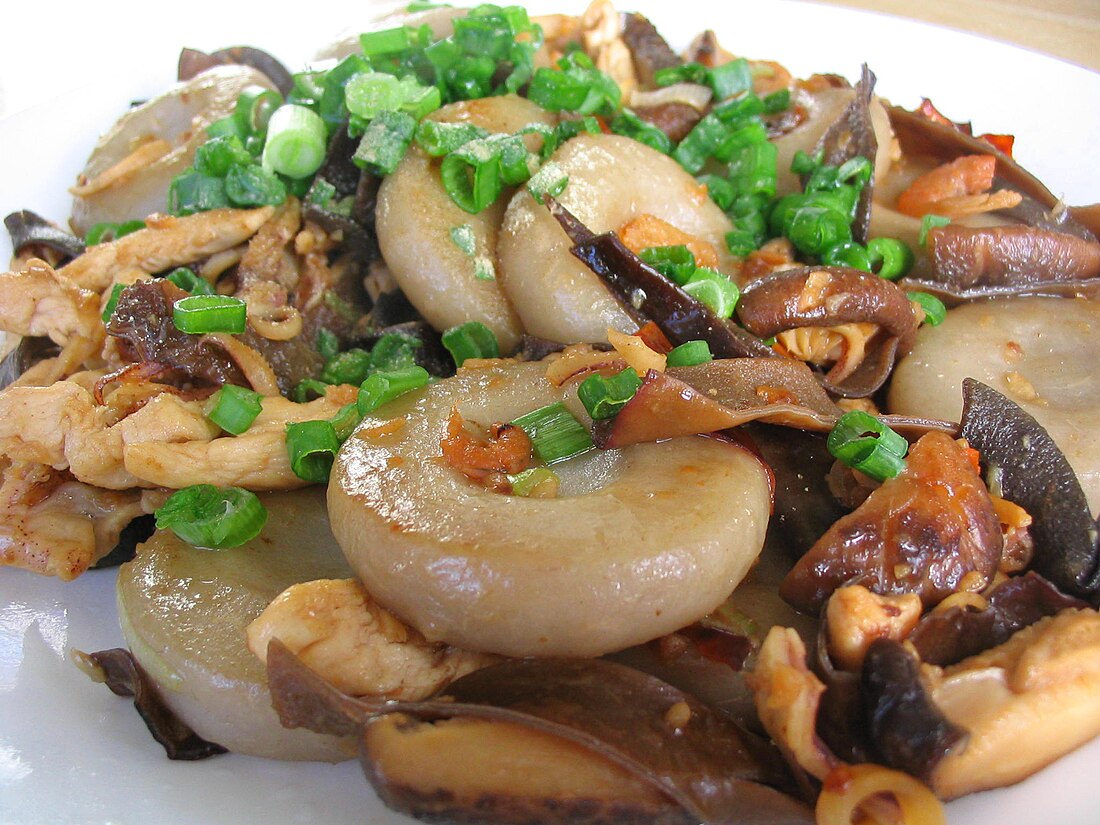Top Qs
Timeline
Chat
Perspective
Hakka cuisine
Ethnic cuisine of the Hakka people From Wikipedia, the free encyclopedia
Remove ads
Hakka cuisine is the cooking style of the Hakka people, and it may also be found in parts of Taiwan and in countries with significant overseas Hakka communities.[1] There are many restaurants in mainland China, Taiwan, Hong Kong, Indonesia, Malaysia, Singapore, and Thailand, as well as in the United States and Canada, that serve Hakka food. Hakka cuisine was listed in 2014 on the first Hong Kong Inventory of Intangible Cultural Heritage.[2]
This article needs additional citations for verification. (March 2015) |
Remove ads
Background
Summarize
Perspective
The Hakka people have a marked cuisine and style of Chinese cooking which is little known outside the Hakka home. It concentrates on the texture of food – the hallmark of Hakka cuisine. Whereas preserved meats feature in Hakka delicacy, stewed, braised, roast meats – 'texturized' contributions to the Hakka palate – have a central place in their repertoire. Preserved vegetables (梅菜) are commonly used for steamed and braised dishes such as steamed minced pork with preserved vegetables and braised pork with salted vegetables. In fact, the raw materials for Hakka food are no different from raw materials for any other type of regional Chinese cuisine where what is cooked depends on what is available in the market. Hakka cuisine may be described as outwardly simple but tasty. The skill in Hakka cuisine lies in the ability to cook meat thoroughly without hardening it, and to naturally bring out the proteinous flavor (umami taste) of meat.
The Hakka who settled in the harbor and port areas of Hong Kong placed great emphasis on seafood cuisine. Hakka cuisine in Hong Kong is less dominated by expensive meats; instead, emphasis is placed on an abundance of vegetables. Pragmatic and simple, Hakka cuisine is garnished lightly with sparse or little flavoring. Modern Hakka cooking in Hong Kong favors offal, an example being deep-fried intestines (炸大腸; zhá dà cháng). Others include tofu with preservatives, along with their signature dish, salt baked chicken (鹽焗雞; yán jú jī). Another specialty is the poon choi (盆菜; pén cài).[3] While it may be difficult to prove these were the actual diets of the old Hakka community, it is at present a commonly accepted view. The above dishes and their variations are in fact found and consumed throughout China, including Guangdong Province, and are not particularly unique or confined to the Hakka population.
Besides meat as source of protein, there is a unique vegan dish called lei cha (擂茶; léi chá). It comprises combinations of vegetables and beans. Although not specifically unique for all Hakka people but are definitely famous among the Hakka-Hopo families. This vegetable-based rice tea dish is gaining momentum in some multicultural countries like Malaysia. Cooking of this dish requires the help from other family members to complete all eight combinations. It helps foster the relationship between family members in return.
Steamed bun (包子) is a popular snack among the Hakka people, especially pork belly bao (扣肉包) that is stuffed with kiu nyuk. This bun is usually made with flour, water, sugar, and yeast, resulting in a soft, fluffy texture when steamed. There is another variety available, such as a dumpling-like bun called tea fruit (茶果), made from glutinous rice. The sweet version is filled with sweetened black-eyed pea paste or peanuts, while the salty version contains preserved vegetables or radishes.
Remove ads
Notable dishes
Summarize
Perspective
Hakka food also includes other traditional Taiwanese dishes, just as other Taiwanese ethnic groups do. Some of the more notable dishes in Hakka cuisine are listed as follow:
Remove ads
Hakka cuisine in South Asia
In India, Pakistan and other South Asian countries, there is something locally known "Hakka cuisine." This variation of Chinese-style cuisine is, in reality, mostly Indian Chinese cuisine and Pakistani Chinese cuisine. It is called "Hakka cuisine" because, in India and areas of Pakistan, many owners of restaurants who serve this cuisine are of Hakka origin. Typical dishes include 'chilli chicken' and 'Dongbei (northeastern) chow mein/hakka noodles' (an Indian version of real Northeastern Chinese cuisine), and these restaurants also serve traditional South Asian dishes such as pakora. Being very popular in these areas, this style of cuisine is often mistakenly credited as being representative of Hakka cuisine in general, whereas the authentic style of Hakka cuisine is rarely known in these regions.
Outside of South Asia, the premier place to enjoy Indian-Pakistani-Chinese cuisine is in Toronto, Canada,[4] due to most of it being halal. In Toronto, "Hakka Chinese food" almost universally refers to Indian-Chinese cuisine, not Hakka cuisine in general.[5]
Hakka cuisine in Thailand
In Thailand, Bangkok's Chinatown is Yaowarat and including neighboring areas such as Sampheng, Charoen Chai, Charoen Krung, Suan Mali, Phlapphla Chai or Wong Wian Yi Sip Song Karakadakhom (July 22 Circle). In the past, many Hakka restaurants are located in the Suan Mali near Bangkok Metropolitan Administration General Hospital. But now they had moved into many places, such as Talad Phlu, which is also one of the Chinatown as well.[6]
Remove ads
See also
References
External links
Wikiwand - on
Seamless Wikipedia browsing. On steroids.
Remove ads






